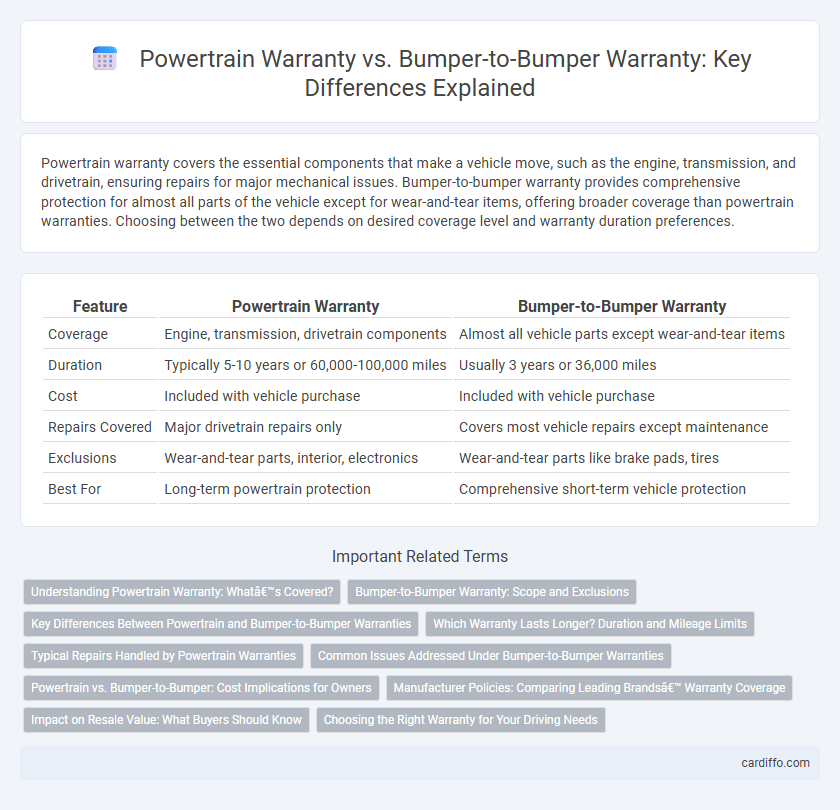Powertrain warranty covers the essential components that make a vehicle move, such as the engine, transmission, and drivetrain, ensuring repairs for major mechanical issues. Bumper-to-bumper warranty provides comprehensive protection for almost all parts of the vehicle except for wear-and-tear items, offering broader coverage than powertrain warranties. Choosing between the two depends on desired coverage level and warranty duration preferences.
Table of Comparison
| Feature | Powertrain Warranty | Bumper-to-Bumper Warranty |
|---|---|---|
| Coverage | Engine, transmission, drivetrain components | Almost all vehicle parts except wear-and-tear items |
| Duration | Typically 5-10 years or 60,000-100,000 miles | Usually 3 years or 36,000 miles |
| Cost | Included with vehicle purchase | Included with vehicle purchase |
| Repairs Covered | Major drivetrain repairs only | Covers most vehicle repairs except maintenance |
| Exclusions | Wear-and-tear parts, interior, electronics | Wear-and-tear parts like brake pads, tires |
| Best For | Long-term powertrain protection | Comprehensive short-term vehicle protection |
Understanding Powertrain Warranty: What’s Covered?
Powertrain warranty covers essential components such as the engine, transmission, and drivetrain, ensuring repairs or replacements for mechanical failures within the coverage period. This type of warranty typically excludes non-mechanical parts like electronics, tires, and interior features, which are covered under bumper-to-bumper warranty. Understanding the scope of powertrain warranty helps consumers prioritize long-term protection for the vehicle's core systems.
Bumper-to-Bumper Warranty: Scope and Exclusions
Bumper-to-bumper warranty covers almost all vehicle components, including electrical systems, air conditioning, and interior features, offering comprehensive protection against defects in materials or workmanship. This warranty excludes routine maintenance items such as brake pads, tires, and wiper blades, as well as damages caused by accidents, misuse, or environmental factors. Understanding the clear distinction between covered systems and exclusions helps vehicle owners maximize warranty benefits while avoiding unexpected repair costs.
Key Differences Between Powertrain and Bumper-to-Bumper Warranties
Powertrain warranties cover essential components such as the engine, transmission, and drivetrain, ensuring repairs for parts critical to vehicle movement, while bumper-to-bumper warranties offer comprehensive coverage for nearly all vehicle components excluding wear-and-tear items. Powertrain warranties typically last longer, often up to 100,000 miles or more, whereas bumper-to-bumper warranties usually expire within the first 3 years or 36,000 to 50,000 miles. Understanding these key differences helps consumers evaluate the scope and duration of protection based on vehicle usage and potential repair costs.
Which Warranty Lasts Longer? Duration and Mileage Limits
Powertrain warranties generally last longer than bumper-to-bumper warranties, often covering 5 to 10 years or 60,000 to 100,000 miles compared to bumper-to-bumper coverage, which usually spans 3 years or 36,000 miles. Powertrain warranties focus specifically on critical components like the engine, transmission, and drivetrain, providing extended protection due to their high repair costs. Bumper-to-bumper warranties offer broader coverage for most vehicle parts but expire sooner, making powertrain warranties the longer-lasting option for many car owners.
Typical Repairs Handled by Powertrain Warranties
Powertrain warranties typically cover essential components such as the engine, transmission, and drivetrain, addressing repairs related to mechanical failures or defects in these systems. Unlike bumper-to-bumper warranties that offer broader coverage including electronics and interior features, powertrain warranties focus on critical parts responsible for vehicle movement and performance. Common repairs under powertrain warranties include transmission rebuilds, engine part replacements, and differential repairs, minimizing costly out-of-pocket expenses for major powertrain issues.
Common Issues Addressed Under Bumper-to-Bumper Warranties
Bumper-to-bumper warranties typically cover a wide range of common vehicle issues including electrical system malfunctions, air conditioning failures, and infotainment problems, providing comprehensive protection beyond just the engine and transmission. Unlike powertrain warranties that focus on essential components like the engine, transmission, and drivetrain, bumper-to-bumper warranties address most non-wear-and-tear parts such as the suspension, brakes, and interior electronics. This broader coverage helps reduce unexpected repair costs and ensures the vehicle remains in optimal working condition during the warranty period.
Powertrain vs. Bumper-to-Bumper: Cost Implications for Owners
Powertrain warranties typically cover essential engine, transmission, and drivetrain components, resulting in lower upfront costs compared to comprehensive bumper-to-bumper warranties that protect nearly all vehicle parts. Owners often face higher premiums with bumper-to-bumper coverage due to its extensive protection scope, which reduces out-of-pocket expenses for repairs but increases insurance fees. Choosing between these warranties requires balancing potential repair costs against monthly payment affordability.
Manufacturer Policies: Comparing Leading Brands’ Warranty Coverage
Leading automotive manufacturers offer varied powertrain and bumper-to-bumper warranty policies, reflecting differences in coverage duration and components included. Powertrain warranties typically cover the engine, transmission, and drivetrain for extended periods, often ranging from 5 to 10 years or 60,000 to 100,000 miles, depending on the brand, while bumper-to-bumper warranties provide broader protection, excluding wear-and-tear items, commonly lasting 3 to 5 years or 36,000 to 60,000 miles. Brands like Hyundai and Kia lead with longer bumper-to-bumper terms, whereas Ford and Toyota provide competitive powertrain warranties focused on core mechanical systems.
Impact on Resale Value: What Buyers Should Know
Powertrain warranties typically cover essential components like the engine, transmission, and drivetrain, offering buyers confidence in the vehicle's mechanical reliability and often enhancing resale value by reducing potential repair costs. Bumper-to-bumper warranties provide broader coverage, encompassing almost all parts of the vehicle except wear items, which can significantly increase buyer appeal and resale price due to the extended assurance of comprehensive protection. Understanding the scope and duration of each warranty type helps buyers evaluate how such coverage impacts the vehicle's long-term value and marketability.
Choosing the Right Warranty for Your Driving Needs
Powertrain warranties cover essential components such as the engine, transmission, and drivetrain, making them ideal for drivers who prioritize protection against costly mechanical failures. Bumper-to-bumper warranties provide comprehensive coverage for nearly all vehicle parts, excluding wear items, suitable for those seeking extensive protection and peace of mind. Selecting the right warranty depends on your driving habits, vehicle usage, and budget, ensuring optimal financial safeguard against potential repairs.
Powertrain Warranty vs Bumper-to-Bumper Warranty Infographic

 cardiffo.com
cardiffo.com